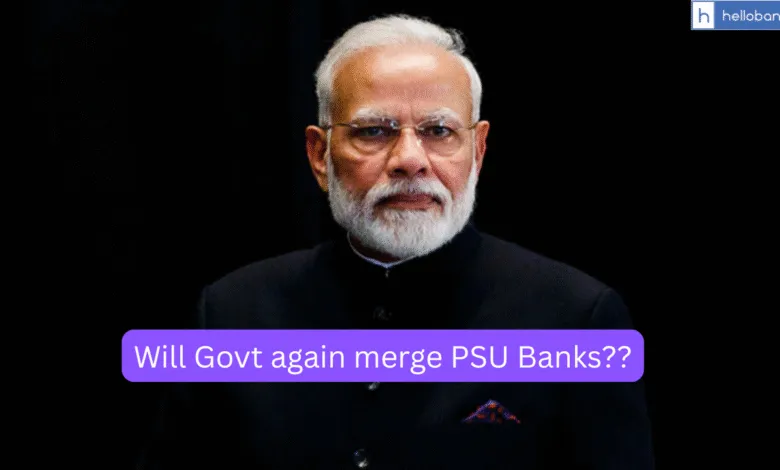Bank Amalgamation Back in News: Will India again Witness Merger of Public Sector Banks?

| ➡️ Get instant news updates on Whatsapp. Click here to join our Whatsapp Group. |
The debate around consolidation of public sector banks (PSBs) has again resurfaced. The reports suggest that the government may once again consider merging state-run lenders to create larger, globally competitive institutions. According to The Economic Times, the issue is likely to be discussed at the upcoming PSB Manthan.
The Finance Ministry is planning to organise a two-day PSB Manthan from September 12 to discuss and design the next wave of reforms for public sector banks (PSBs). MD&CEOs of all 12 PSBs will participate in the event to discuss on improving the performance of Public Sector Banks. Click here to read about PSB Manthan.
If the government goes ahead with another round of bank amalgamations, it will mark a major turning point for the Indian banking industry. Such a move could reshape the structure of public sector banks by reducing their number but strengthening their size and global reach. For customers, this may mean access to better services, stronger digital platforms, and wider branch networks, though short-term challenges like account migration or branch rationalisation could also arise.
A Look Back: From 27 Banks to 12
India has already witnessed one major wave of bank amalgamation in 2020, when the number of PSBs was reduced from 27 to just 12. That round of mergers created bigger entities such as Punjab National Bank (PNB) absorbing Oriental Bank of Commerce and United Bank, or Union Bank merging with Andhra Bank and Corporation Bank. At that time, the objective was to strengthen balance sheets, improve efficiency, and give Indian banks the scale needed to compete globally.
Right now India has following Public Sector Banks:
- State Bank of India (SBI)
- Punjab National Bank (PNB)
- Bank of Baroda (BoB)
- Canara Bank
- Union Bank of India
- Indian Bank
- Bank of India (BoI)
- Central Bank of India
- Indian Overseas Bank (IOB)
- UCO Bank
- Bank of Maharashtra (BoM)
- Punjab & Sind Bank (PSB)
What’s the need for more Merger?
According to senior officials, the logic for another round of consolidation is simple: Indian banks need to grow much larger if they want to compete on the global stage. At present, only State Bank of India (SBI) and HDFC Bank figure among the world’s top 100 lenders by assets. For a fast-growing economy like India, that number is seen as too low.
The official quoted by ET also stressed that any new mergers will not be imposed unilaterally. They will depend on synergies between banks and will be carried out in consultation with the lenders themselves, just like in 2020. The aim would be to create at least three to four very large banks that can anchor India’s financial system and support big-ticket investments.
Another important reason behind the merger is India’s massive infrastructure requirement. The country will need close to $4.5 trillion in infrastructure investment by 2040 to sustain its growth story. Stronger, bigger banks aligned with specialised financiers like NaBFID (National Bank for Financing Infrastructure and Development) and IIFCL (India Infrastructure Finance Company) will be better positioned to channel funds into mega projects such as highways, power plants, and urban development.
The timing also matters. Recent data shows that domestic credit growth is slowing down. Non-food credit growth in July 2025 was 9.9% year-on-year, down from 13.7% in July 2024. Research by CareEdge Ratings shows that loans to large industries grew by less than 1% in July, pointing to weak demand from corporates and persistently low private capital expenditure.
This raises a crucial question: do we need more banks to expand credit or fewer, bigger banks to lend more effectively?
What to Expect
The upcoming PSB Manthan will likely set the tone for the government’s approach. If fresh amalgamations are announced, it would mark another milestone in reshaping India’s banking sector. For employees, customers, and investors, the news of consolidation always brings mixed reactions. While mergers can improve efficiency and financial strength, they also raise concerns about branch rationalisation, cultural integration, and the loss of smaller bank identities.

It will be a nice decision for Indian economy
Mergers will create more problem in operation. Better stop opening of new banks.. STOP MERGER
I do not think further mergers are required Already we have reduced 27 PSB to 12 The country needs to generate employment opportunities also beside keeping focus on profitability of PSBs
Merger will be positive as of now all 12 PSBs are competing against each other and private lenders are gaining. After merging there shall be at max 4-5 PSBs then they’ll have perfect market competition and PSBs will grow. There will be Enhanced Financial Stability & Efficiency. Increased lending capacity.
Mergers or not the need of the hour is better customer service coupled with taking growth momentum in a painless way for people and bank employees
Brick and mortar branches in u
cosmopolitan urban centres need to be streamlined so that huge rental outgo will be curtailed,.this is to be done after identifying suitable match but before implementing merger. Branches based in real rural areas need to be clubbed into four or five based on North East West South and central, as almost all such rural branches are computerised it would be seamlessly unified and placed under NABARD.
Merger always ruins smaller banks. It never stop the only ruin of banks but their shortlist of staff, we have already from 27 to 12, so not again. Stop mergers
Earlier 27 Nationalised banks. Public had liberty to avail any service as per their requirements. If one bank rejected others will support. Now 12. What the Govt achieved by merger? Last time weak bank was merged with strong bank which which brought down the strong bank towards weak where as the target was take the weak towards strong. Result was reversed. Same way now 12 banks may be reduced to 5. Ultimately 5 will become One. One time morning it will be privatised. Why Government not merging uniqt Various departments in to single and reduce ministers. Late Prime minister Indra Gandhi made many private banks as Nationalised in order to avoid banks doing Money lending for Rich only. Now all nationalised banks will be merged and finally fulfill the hidden agenda of the Government.